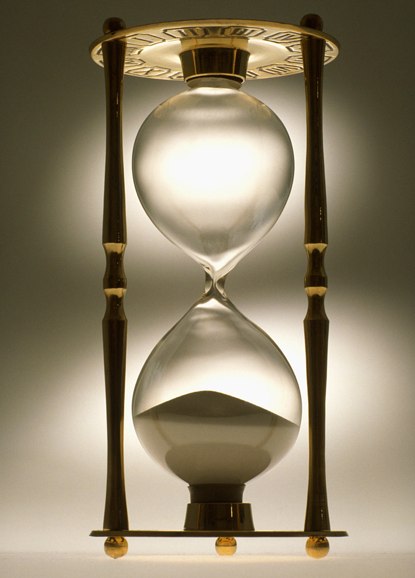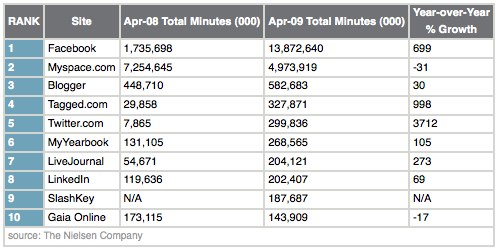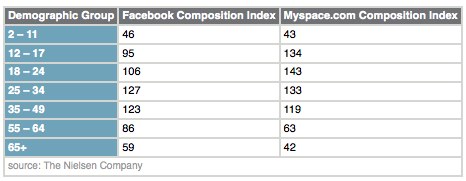
I just read an interesting report published by Nielsen that examines time spent on multiple Social and Micro Networks. The study compares total minutes in April 2009 compared to April 2008. The results are not as much surprising as they are revealing.
According to Nielsen, total minutes spent on social networking sites has increased 83 percent year-over-year.
Twitter, the social media darling that can never seem to satisfy our insatiable appetite for all things orbiting the Twitterverse, experienced extraordinary growth in the last year with total time spent up by over 3,700%. While currently ranked 5th, Twitter’s dramatic groundswell is the most notable on the list followed by Tagged.com, a five year old social network that experienced a 1,000% year over year increase in engagement.
Time spent on Facebook, the popular network that now boasts a $10 billion valuation, increased nearly 700 percent year-over-year, growing from 1.7 billion minutes in April 2008 to 13.9 billion in April 2009.
MySpace clocked in at a very distant second place with just under 5 billion minutes. Out of 10 companies on the list, MySpace is one of the only two that showed a decline in time spent. From 2008 – 2009, time spent on MySpace is down 31% and Gaia Online also saw a 17% reduction.
Other notable entries include My Yearbook (up 105%) and LinkedIn (up 69%). What is unclear to me however, is the inclusion of Blogger and LiveJournal in this report. While technically each serve as a network, the overall usage of the services is related mainly to their publishing aspects and less on their inter-personal connectivity.
Top 10 Social Networking and Blog Sites Ranked by Total Minutes for April 2009 and Their Year-over-Year Percent Growth (U.S., Home and Work)

Nielsen also observed the defining age groups for these popular social networks. Visitors aged 25 to 34 and 35 to 49 were the highest indexing age groups on Facebook, representing 27 percent and 23 percent as more likely to visit the site than the average user, respectively. The highest indexing demographics on Myspace.com, in contrast, were those aged 18 to 24 and 12 to 17.

Perhaps Twitter’s surge symbolizes the disparity between popularity and adoption. Yes, the service is on the rise and it’s influencing popular culture and how we communicate with each other in the process. But, the real star of this analysis is Facebook.
However, as our attention continues to thin as we’re introduced to new content, people, networks, and shiny new apps, even the most popular communities are not infallible.
While attending TWTRCON in San Francisco, I was immersed in dialogue with Steve Rubel, Paul Boutin, and David Berlind. The discussion centered on history versus sociology and psychology, hinging on the idea that any given network’s “15-minutes” of fame (read: popularity and importance, not lifespan) translated into roughly five years. Remember the days of Friendster’s dominance and MySpace’s invulnerability?
If you subscribe to Zuckerberg’s Law, then you believe that people will share twice as much information online year over year. His idea suggests that as we embrace the social web as a greater society, our comfort levels will ease and succumb to the activity of our peers, encouraging us to share increasing volumes of personal and professional content online. But, that isn’t relegated to just Facebook, that could be true for all social networks.
What if the rate in which popular social networks innovate and earn prominence actually decreased over time instead of hovering at a five year benchmark? The introduction of new and arresting networks and tools is only going to continue to multiply and intensify. We have yet to truly taste mobile networking or find the killer app for the living room. Competition for our attention is escalating and it’s just a matter of time until our experimentation officially leads to distributed and uncommitted presences. Perhaps this will lead to a series of strategic acquisitions to prolong prestige, relevance, and stature.
I suggested that the rate in which our attention is focused is both diminishing and extending during this period of increasingly socialized interactivity. Meaning, how we adopt, communicate, share, discover, and observe within social networks is ultimately uncertain and still in the process of definition and documentation. We’re writing the book as we go…much of this is so new, we have yet to see the balance, individual adoption and sustainable activity, and long-term effect.
The excitement of having tools that allow us to instantly connect with people who share in passions, interests, and contacts all over the world combined with the psychological impact of this new genre of personal “micro” fame is seductive and not necessarily in alignment with how we will eventually fold these tools and ensuing behavior into our day-to-day cadence.
The reality is that our friends and networks of influence determine our location and participation. This is a competition not for popularity, but for you and your time and loyalty This is indeed, the Social Economy.
Helpful Posts on PR 2.0:
– Gazing into The Twitterverse
– This is Not a Sponsored Post: Sponsored Conversations & the FTC
– Reviving the Traditional Press Release
– Twitter, Acquisition vs. Retention
– You Are Significant
– The Art and Science of Blogger Relations – Updated eBook
– In Social Media, The SEC Protects Investors and Companies by Removing “Relations” from IR
– Twitter Flutters into Mainstream Culture: The New Competition for Attention Starts with You
– The Social OS, The Battle Between Facebook and Twitter is the New Mac vs. PC
– The Domino’s Effect
– Can The Statusphere Save Journalism
– The Conversation Index
– Social Media Influences Buying Decisions
– Is Social Media Recession Proof?
– The End of the Innocence
– The Social Effect and Disruption Theory
– Twitter and Social Networks Usher in a New Era of Social CRM
– In the Statusphere, ADD Creates Opportunities for Collaboration and Education
– Humanizing Social Networks, Revealing the People Powering Social Media
– I Like You The Emerging Culture of Micro Acts of Appreciation
– The Ties that Bind Us – Visualizing Relationships on Twitter and Social Networks
– Make Tweet Love – Top Tips for Building Twitter Relationships
– Are Blogs Losing Their Authority to the Statusphere
– Twitter Tools for Communication and Community Professionals
– Reinventing Crisis Communications for the Social Web
Connect with me on:
Twitter, FriendFeed, LinkedIn, Tumblr, Plaxo, Plurk, Identi.ca, BackType, Social Median, or Facebook
—
![]()
Subscribe to the PR 2.0 RSS feed.

Kindle users, subscribe here.
—
Now available:


—
pr pr+2.0 pr2.0 public+relations marketing advertising interactive social+media socialmedia brian+solis social media media2.0 media+2.0 2.0 smo social+media+optimization marcom communication publicity facebook nielsen twitter tweet mark+zuckerberg sociology anthropology psychology science digital





To fully understand this, I think I'd need a more robust definition of "time spent" and how the measurements contributing to that report were made.
Facebook is so completely different from Twitter: the former has tons and tons of activity to engage in and actually "spend time" dwelling. Twitter is by its own design mostly just a clearing house routing messages around.
Plus, Twitter has a much more grandiose myriad of clients and other apps built to draw from it– many people don't actually spend any time on Twitter.com at all.
It would seem that measurement of time spent actually on Facebook would be much easier to measure than Twitter, and that "engagement" or some other word would be much more useful.
With stats like these, it amazes me that still so many of my friends are not on FB or Twitter and are missing out on the conversation. If you don't participate, you miss out on social info, social mores, etc. In essence, you become like one of my relatives, who hasn't watched a movie in 40 years because they are "too violent." She has no reference points to catch phrases, customs, historical events, etc because she deliberately isolated herself.
3700%?!? Wow. Talk about a major increase. I'm surprised at the % but not about the increase. People are just rushing to Twitter from everywhere.
Brian, it was a pleasure meeting you yesterday at the Internet Week talk in NYC, extending online connections with an offline event. I recommend it to everybody.
And today, of course a great post! Very informative, with questions that make you think beyond these tools that dominate the social web today. As always we have linked to it on our brand blog Unbound Edition for more marketing professionals to read and learn. Thanks!
I can't I'm totally surprised by those numbers. Social media is the hot topic now days and Facebook and Twitter are the darlings of the users right now.
Of course, Twitter also seems to have stats pointing towards a poor retention rate so I'm not sure how it all corresponds.
But the fact remains that now is the golden time for social media – if the right things are done to keep users attention. There are so many different sites out there to network on now and some are going about it unique ways. http://www.HopOnThis.com has it to where users are eligible for prizes every month for being constantly active on the site. It's one way to ensure engagement over time and that's what advertisers are looking for.
Very very interesting post..I like this one. gotta bookmark this one.
Cheers,
Buat Duit Dengan Blog